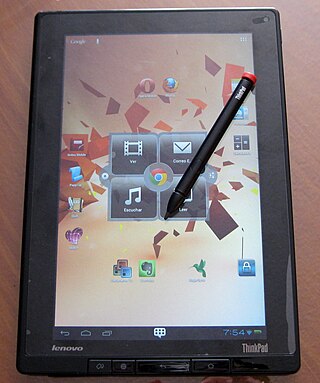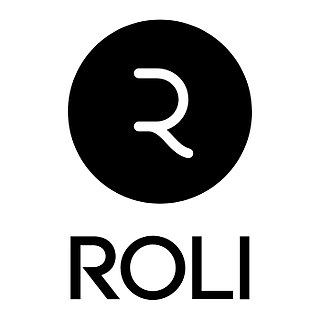
MIDI is a technical standard that describes a communication protocol, digital interface, and electrical connectors that connect a wide variety of electronic musical instruments, computers, and related audio devices for playing, editing, and recording music.

Microsoft SideWinder was the general name given to the family of digital game controllers developed by Microsoft for PCs. The line was first launched in 1995. Although intended only for use with Microsoft Windows, Microsoft SideWinder game controllers can also be used with macOS, Mac OS 9 with third-party software, and Linux.

The game port is a device port that was found on IBM PC compatible and other computer systems throughout the 1980s and 1990s. It was the traditional connector for joystick input, and occasionally MIDI devices, until made obsolete by USB in the late 1990s.

An electronic keyboard, portable keyboard, or digital keyboard is an electronic musical instrument based on keyboard instruments. Electronic keyboards include synthesizers, digital pianos, stage pianos, electronic organs and digital audio workstations. In technical terms, an electronic keyboard is a synthesizer with a low-wattage power amplifier and small loudspeakers.

Novation Digital Music Systems Ltd. is a British musical equipment manufacturer, founded in 1992 by Ian Jannaway and Mark Thompson as Novation Electronic Music Systems. Today the company specializes in MIDI controllers with and without keyboards, both analog and virtual analog performance synthesizers, grid-based performance controllers, and audio interfaces. At present, Novation products are primarily manufactured in China.
Keytar is a keyboard instrument similar to a synthesizer or MIDI controller that is supported by a strap around the neck and shoulders, similar to the way a guitar is held.

A MIDI controller is any hardware or software that generates and transmits Musical Instrument Digital Interface (MIDI) data to MIDI-enabled devices, typically to trigger sounds and control parameters of an electronic music performance. They most often use a musical keyboard to send data about the pitch of notes to play, although a MIDI controller may trigger lighting and other effects. A wind controller has a sensor that converts breath pressure to volume information and lip pressure to control pitch. Controllers for percussion and stringed instruments exist, as well as specialized and experimental devices. Some MIDI controllers are used in association with specific digital audio workstation software. The original MIDI specification has been extended to include a greater range of control features.
The DTX range consists of electronic drum kits and percussion controllers manufactured by the Yamaha Corporation. They currently cover levels from entry-level to pro-range. DTX kits use sampling for their sounds, meaning each kit has built-in digital recordings of real drums, and cymbals. When the drum or cymbal pads are hit, the digital recordings are played back to replicate what is being played. On all kits, the sounds are editable – the pitch can be made higher or lower (tuned) and many other features. The higher the range of the DTX, the more functions there are editable.

A MIDI keyboard or controller keyboard is typically a piano-style electronic musical keyboard, often with other buttons, wheels and sliders, used for sending Musical Instrument Digital Interface (MIDI) signals or commands over a USB or MIDI 5-pin cable to other musical devices or computers. MIDI keyboards lacking an onboard sound module cannot produce sounds themselves, however some models of MIDI keyboards contain both a MIDI controller and sound module, allowing them to operate independently. When used as a MIDI controller, MIDI information on keys or buttons the performer has pressed is sent to a receiving device capable of creating sound through modeling synthesis, sample playback, or an analog hardware instrument. The receiving device could be:

The PS/2 port is a 6-pin mini-DIN connector used for connecting keyboards and mice to a PC compatible computer system. Its name comes from the IBM Personal System/2 series of personal computers, with which it was introduced in 1987. The PS/2 mouse connector generally replaced the older DE-9 RS-232 "serial mouse" connector, while the PS/2 keyboard connector replaced the larger 5-pin/180° DIN connector used in the IBM PC/AT design. The PS/2 keyboard port is electrically and logically identical to the IBM AT keyboard port, differing only in the type of electrical connector used. The PS/2 platform introduced a second port with the same design as the keyboard port for use to connect a mouse; thus the PS/2-style keyboard and mouse interfaces are electrically similar and employ the same communication protocol. However, unlike the otherwise similar Apple Desktop Bus connector used by Apple, a given system's keyboard and mouse port may not be interchangeable since the two devices use different sets of commands and the device drivers generally are hard-coded to communicate with each device at the address of the port that is conventionally assigned to that device.
M-Audio is a business unit of inMusic Brands that designs and markets audio and MIDI interfaces, keyboards and MIDI controllers, synthesizers, loudspeakers, studio monitors, digital DJ systems, microphones, and music software. The company has independent offices in the US, Canada, UK, Germany, France and Japan.

In computer hardware, a port serves as an interface between the computer and other computers or peripheral devices. In computer terms, a port generally refers to the part of a computing device available for connection to peripherals such as input and output devices. Computer ports have many uses, to connect a monitor, webcam, speakers, or other peripheral devices. On the physical layer, a computer port is a specialized outlet on a piece of equipment to which a plug or cable connects. Electronically, the several conductors where the port and cable contacts connect, provide a method to transfer signals between devices.

Disklavier is a brand of reproducing pianos manufactured by Yamaha Corporation. The first Disklavier was introduced in the United States in 1987.

Overture is a music notation (scorewriter) program for Windows and Macintosh platforms, published and developed by Sonic Scores. While Overture is primarily a scorewriter program, it also allows editing the score's MIDI audio playback data in the manner of sequencer and digital audio workstation (DAW) software.

The ThinkPad Tablet is a tablet computer made by Lenovo as part of its series of Android-based tablet devices and is targeted towards business users. Lenovo's tablet offerings are available in both ThinkPad and IdeaPad variants. While the ThinkPad Tablets are designed for business, the IdeaPad tablets, like the laptops of the same name, are meant for home and personal use. These tablets are different from Lenovo's X Series tablets, which are laptop/tablet hybrids and which use Microsoft Windows as their operating system.
Rhythm game accessories are often required to play rhythm games available for various consoles, such as the PlayStation 2, PlayStation 3, Wii, and Xbox 360. These include dance pads, guitar controllers, drum controllers, microphones and turntable controllers. With the exception of microphones, these controllers can generally be used to control any game, but have limited inputs, making them impractical for most games.

ROLI is a London-based music technology company known for its innovative high tech musical instruments, particularly the ROLI Seaboard, a MIDI controller with soft, rubbery keys and continuous, rather than discrete, pitches, and pitch-bending capabilities. ROLI was founded by American-born musician and entrepreneur Roland Lamb in 2009. Its instruments have been used by musicians including Grimes, A. R. Rahman, and Hans Zimmer.

The Seaboard is a musical keyboard-style MIDI controller manufactured by the British music technology company ROLI. It has a continuous sensor-embedded flexible rubber surface for playing the keys instead of traditional lever-style "moving keys". Some models, like the RISE Seaboard Grand, have an onboard sound engine. It has what the manufacturer calls "5D technology" which consists of five types of responsiveness to player actions: "strike", "glide" and "press", front to rear movement "slide" sensitivity, and release–velocity "lift". These responsiveness tools can be used to play the Seaboard with microtonal pitch bend sounds, by moving the finger from note to note, or trigger a vibrato effect into a string patch just by wiggling the finger, which would not be possible on a traditional MIDI controller using only the keys. The Seaboard also features polyphonic aftertouch, and a built-in USB- charged battery. There are three Seaboard models: the small minikey BLOCK, the RISE, and the GRAND, an 88-key keyboard with an onboard sound engine.

A bedroom producer is an amateur musician who creates, performs, and records their music independently using a home studio, often considered a hobbyist opposed to a professional record producer in the recording industry that works in a traditional studio with clients. Typically bedroom producers use accessible digital technology that costs less than the equipment in a professional studio, such as MIDI controller-based instruments and virtual studio technology, to create music for release to the world. While a professional record producer oversees and guides the recording process, often working alongside multiple people such as studio musicians, singers, engineers, mixers, songwriters, arrangers, and orchestrators, a bedroom producer does everything independently: creating the ideas, recording them and processing them for release. Bedroom producers are often self-taught, learning sound design, mixing and music theory by reading music production blogs and watching tutorials on the internet. As bedroom producers depend on the accessibility of music technology, bedroom production has been made easier with advances in home computing power and digital audio workstations (DAW).
The 12 Step foot controller is a bass pedal-style programmable MIDI controller pedal keyboard made by Keith McMillen Instruments which was released in 2011. It has small, soft, rubbery keys that are played with the feet. As a MIDI controller, it does not make or output any musical sounds by itself; rather, it sends MIDI messages about which notes are played to an external synth module or computer music program running on a laptop or other computer. Each key on the 12 Step senses the velocity, aftertouch pressure, and the amount of tilt the player is applying with her feet. The messages from the player's foot presses can be sent via USB to a computer-based virtual instrument or to a synthesizer or other electronic or digital musical instrument.














